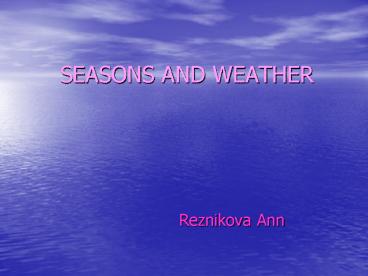SEASONS AND WEATHER - PowerPoint PPT Presentation
1 / 12
Title:
SEASONS AND WEATHER
Description:
SEASONS AND WEATHER Reznikova Ann WINTER Winter is the coldest season of the year. The winter months are December, January and February. The winter days are short and ... – PowerPoint PPT presentation
Number of Views:587
Avg rating:3.0/5.0
Title: SEASONS AND WEATHER
1
SEASONS AND WEATHER
- Reznikova Ann
2
WINTER
- Winter is the coldest season of the year. The
winter months are December, January and February.
The winter days are short and gloomy. It often
snows and it freezes. Winter is a very beautiful
season. Some people like it very much. It is
pleasant to walk when it is not very cold and it
snows. The ground is covered with snow. The trees
and the roofs white with snow too.
3
SPRING
- March, April and May are spring months. Spring is
the most pleasant of all the seasons of the year.
The weather is getting warmer and warmer,
everything changes and seems to revive. The trees
begin to bud. Sometimes it rains, but there are
no rough the sun shines brightly. The grass is
green and one can see a lot of flowers peeping
out from it. In spring all the migratory birds
return. They sing sweetly on the branches of the
trees.
4
SUMMER
- The summer months are June, July and August.
Summer is the hottest season of the year. The
days are longest in summer. The longest day of
the year is the 22nd of June. Some people like
summer best of all. All of us enjoys summer with
its cloudless sunshine, with its gardens and
meadows full of flowers. There as a lot of fruit
and vegetables at that time. In summer many
people leave town and spend the hottest time in
the country or at the seaside.
5
AUTUMN
- After summer autumn comes. The autumn months are
September, October and November. The warm days of
early autumn are called the Indian Summer or
the Golden Autumn. The Golden Autumn is
really beautiful with its yellow, red and brown
trees and golden leaves falling down. Autumn is
the season of fruit and vegetables. But the days
become shorter and the nights longer and darker.
The weather is not so good as in spring and in
summer. It often rains and the air gets colder
and colder.
6
DIFFERENT KINDS OF WEATHER
- A thunderstorm
- A snowfall
- Fog
- A waterspout
7
A THUNDERSTORM
- A thunderstorm, also known as an electrical storm
or a lightning storm, is a form of weather
characterized by the presence of lightning and
its effect thunder. It is usually accompanied by
heavy rain and sometimes snow, hail, or no
precipitation at all. Thunderstorms may line up
in a series, and strong or severe thunderstorms
may rotate.
8
A SNOWFALL
- Snow is a type of precipitation in the form of
crystalline water ice, consisting of a multitude
of snowflakes that fall from clouds. The process
of this precipitation is called snowfall. Since
snow is composed of small ice particles, it is a
granular material. It has an open and therefore
soft structure, unless packed by external
pressure.
9
Types of snow
- Blizzard - a long-lasting snow storm with intense
snowfall and usually high winds. Particularly
severe storms can create whiteout conditions
where visibility is severely reduced. - Columns - a class of snowflakes that is shaped
like a six sided column. One of the 4 classes of
snowflakes. - Flurry-a period of light snow with usually little
accumulation with occasional moderate snowfall. - Lake-effect snow produced when cold winds move
across long expanses of warmer lake water,
picking up water vapor which freezes and is
deposited on the lake's shores.
10
FOG
- Fog is a cloud bank that is in contact with the
ground. A cloud may be considered partly fog for
example, the part of a cloud that is suspended in
the air above the ground is not considered fog,
whereas the part of the cloud that comes in
contact with higher ground is considered fog. Fog
is distinguished from mist only by its density,
as expressed in the resulting decrease in
visibility Fog reduces visibility to less than 1
km, whereas mist reduces visibility to no less
than 2 km.
11
A waterspout
- A waterspout is an intense columnar vortex
(usually appearing as a funnel-shaped cloud) that
occurs over a body of water and is connected to a
cumuliform cloud. In the common form, it is a
nonsupercell tornado over water, and brings the
water upward. It is weaker than most of its land
counterparts.
12
- THE END!































